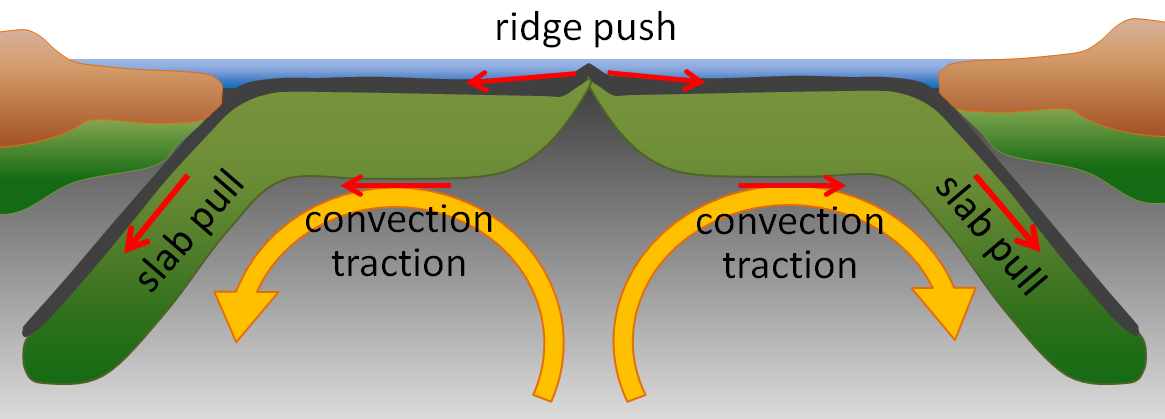
Plate Tectonics |
||
The core is much hotter than the mantle, so heat is transferred to the bottom of the mantle. This heated area begins to rise up until it reaches the transition zone. Here it cools and starts to descend back down to the bottom of the mantle. This is called a convection cell. A similar process happens in the upper mantle (the asthenosphere). Hot mantle material rises up to beneath the lithosphere, where it cools. Because the asthenosphere is ductile, as the convecting material moves beneath the lithosphere it moves the lithosphere with it, causing the plates to move.

However, plate motion is much too complex for this to be the only reason.
Scientists believe that there are two other forces drive plate motions: Ridge push and Slab Pull.
As the subducting plate descends into the mantle, it pushes aside the mantle material. This causes the asthenosphere to move away from this area. Where does it go? As mantle convection moves upward, this additional material joins with it and rises up at spreading centers or hot spots, which helps to spread the plates apart.
Heavy items like ice sheets and mountains push aside the rocks in the asthenosphere, as do the subducting oceanic plates. The rocks flow along with mantle convection to spreading centers and help them to push the plates apart. So, the pushing and pulling of the plates and mantle convection work together to move the plates around.

Image from: "Models for plate motion mechanisms" by BC Open Textbooks is licensed under CC BY-NC 4.0
This is done by measuring the distance between where a spot was in the past to where it is today. Example: We know where the Hawai'i hot spot is now. We also know that the island of Kaua'i used to be on the same hot spot 5 million years ago. Kaua'i is now 519 km from the hot spot, so the plate has moved 519km/5ma, or 10.4 cm/yr.
The map below shows the plate boundaries with arrows indicating the relative amount of movement for each plate. The longer the arrow, the faster the plate is moving.

Image from: "Tectonic plates boundary types & movement" by USGS is licensed under CC BY-NC 4.0
GPS and similar technology can show scientists how fast the plates are moving in real-time, not how fast they were moving, like with the absolute velocity method. The results are similar, however.
Note how the North American and Eurasian plates are moving in one direction on one side, and in a slightly different direction on the other. This can cause stress in the middle areas.

<< back |
|
copyright Sonjia Leyva 2022 |
|